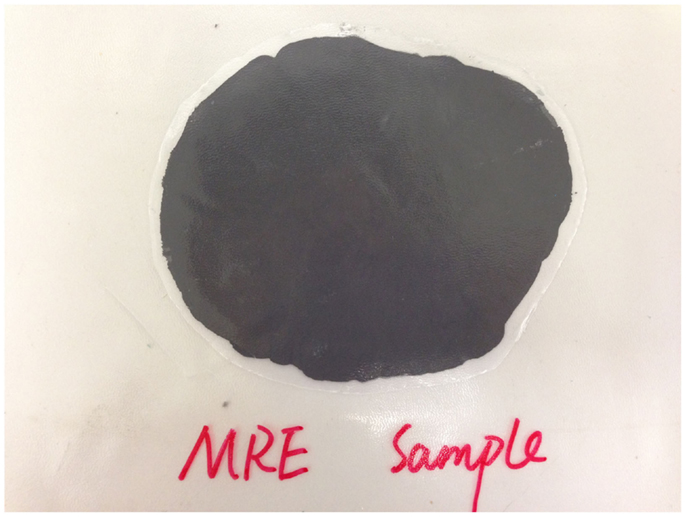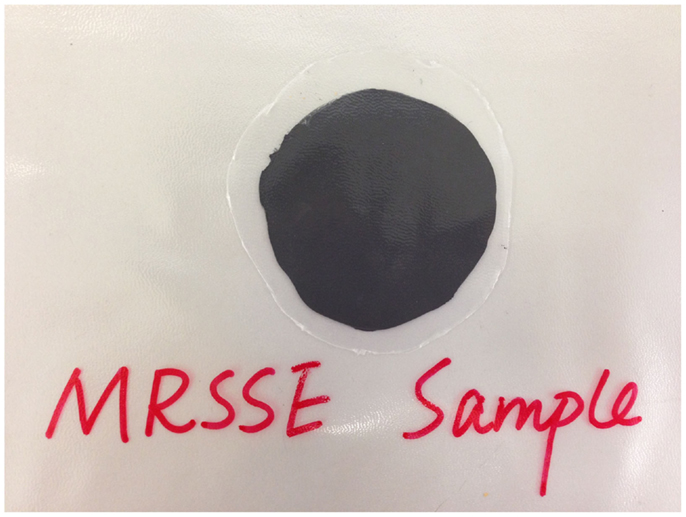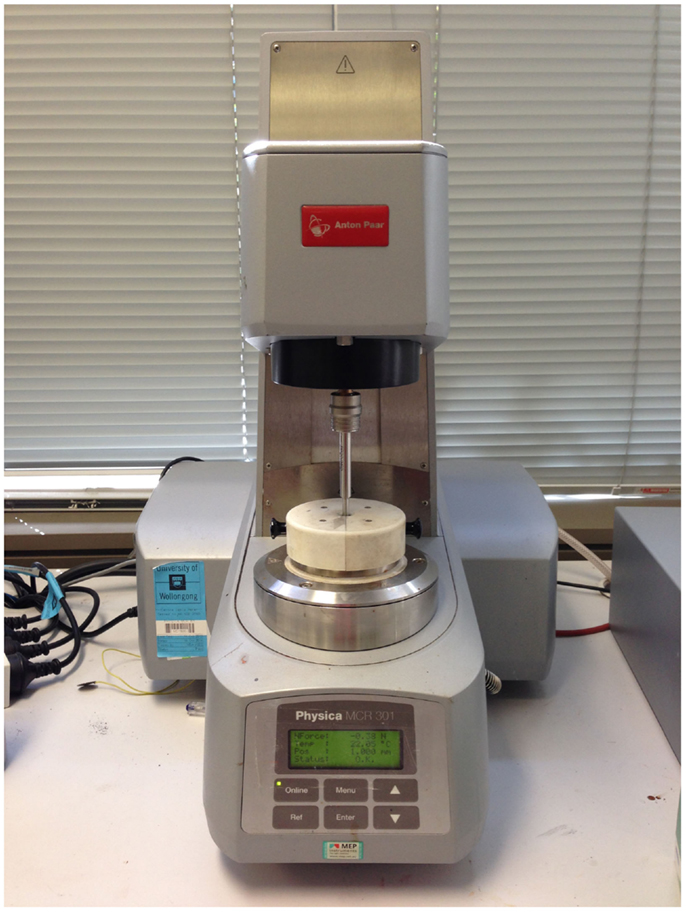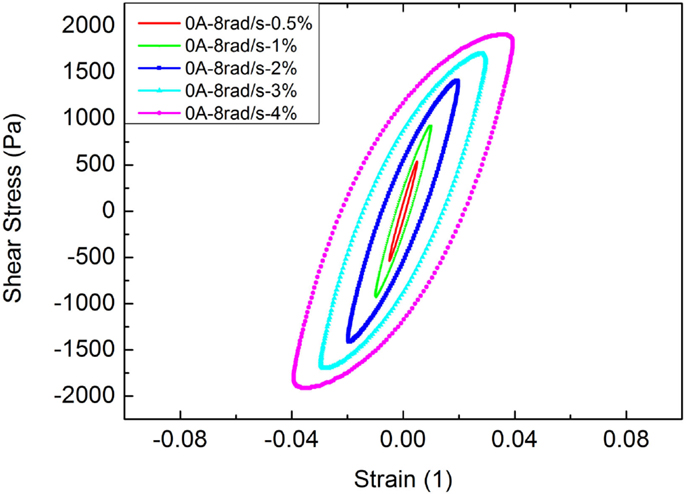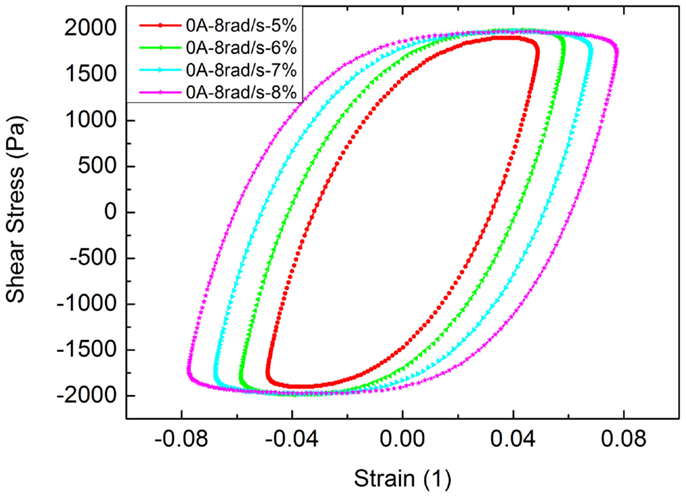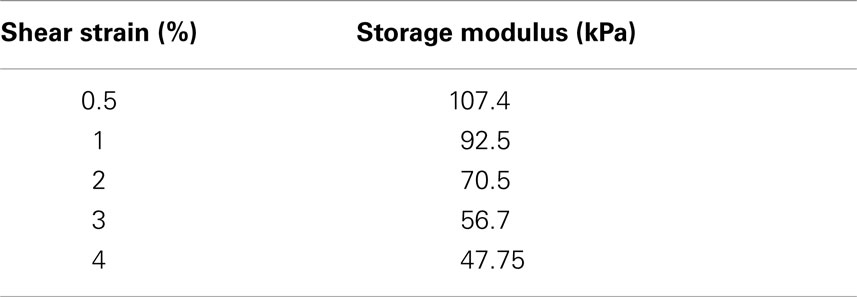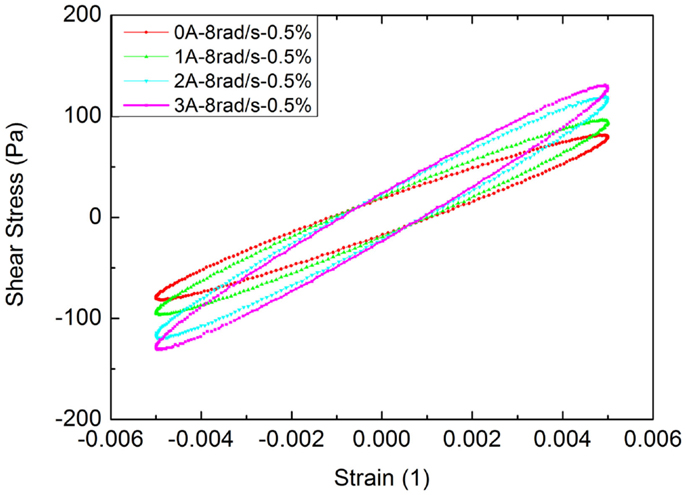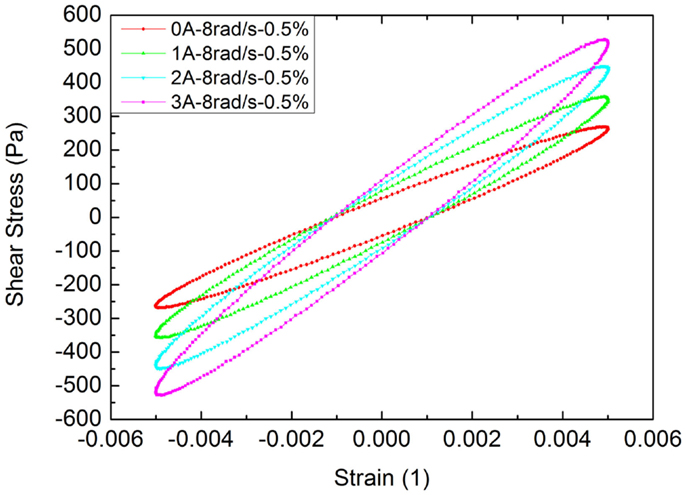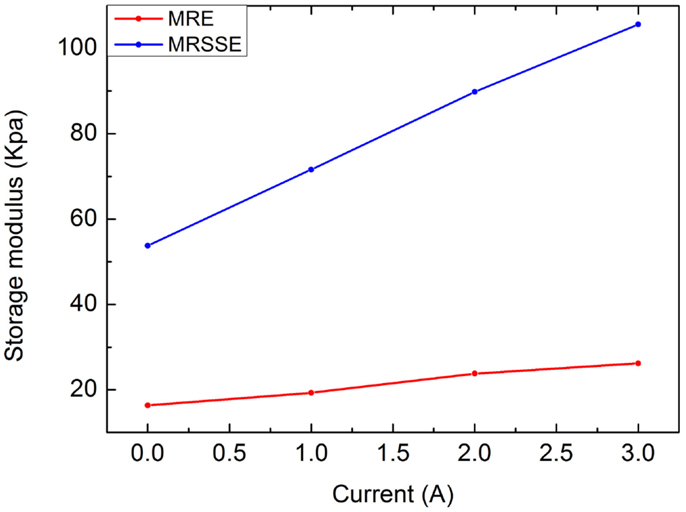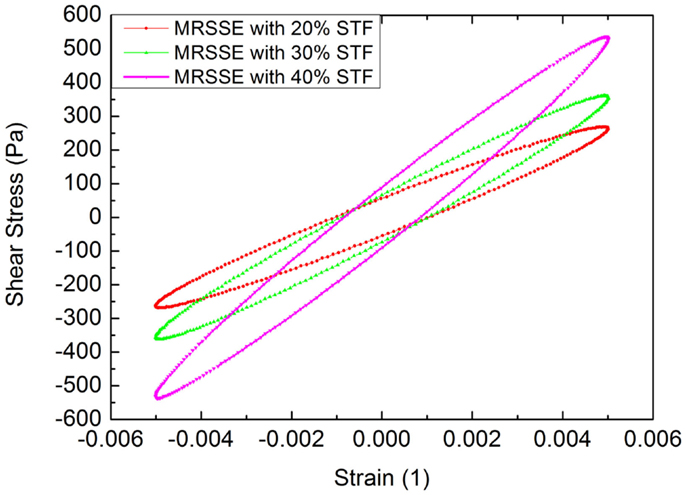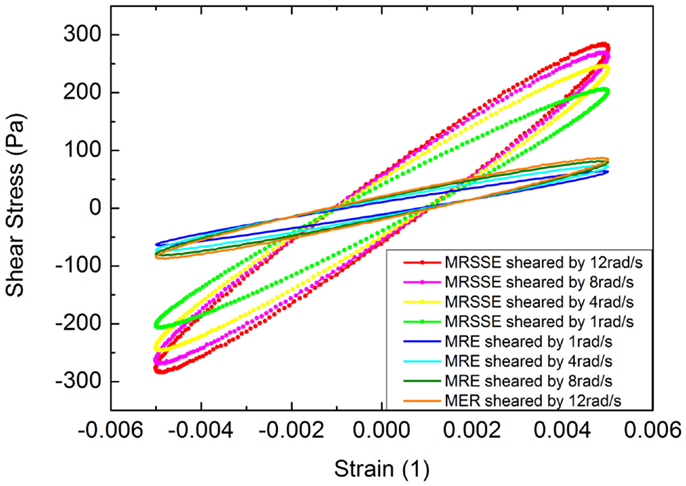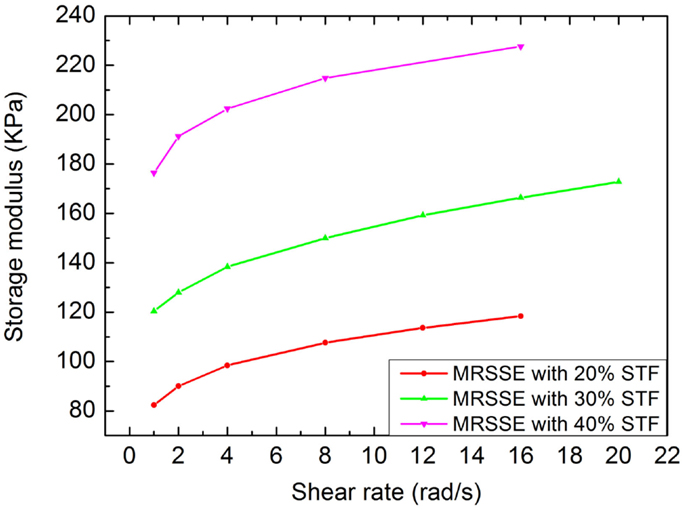Fabrication and characterization of magneto-rheological shear-stiffened elastomers
- 1School of Mechanical, Materials and Mechatronic Engineering, University of Wollongong, Wollongong, NSW, Australia
- 2School of Electrical, Computer and Telecommunications Engineering, University of Wollongong, Wollongong, NSW, Australia
- 3ARC Centre of Excellence for Electromaterials Science, Innovation Campus, University of Wollongong, Wollongong, NSW, Australia
- 4School of Mechanical and Electrical Engineering, China Jiliang University, Hangzhou, China
This study presents a novel smart solid material called magneto-rheological shear-stiffened elastomer (MRSSE) whose storage modulus can be changed obviously by both magnetic field and shear rate. The MRSSE was fabricated by mixing shear-thickening fluids (STFs) with carbonyl iron particles and silicon rubber thoroughly. All of the samples were then tested by using a parallel-plate rheometer. It is noted that increasing strain induces a slight decrease on the storage modulus, but an increase on the maximum shear stress of the samples before a critical shear strain. In terms of the magneto-rheological effect, MRSSE is more sensitive to the change of magnetic field because it shows a faster increase in storage modulus and the maximum shear stress with growing current levels when compared to magneto-rheological elastomer. The comparison results between different MRSSE samples reveal that the bigger the mass fraction of STFs the larger the storage modulus when the samples are loaded at a same shear rate. Additionally, the MRSSE shows an obvious increase on the storage modulus and the maximum shear stress when the shear rate increases.
Introduction
Scientists and engineers have been devoted to discovering smart materials with adaptive capabilities for decades. The interest in these materials is their unusual physical properties that can be exploited for multi-purposes. Such materials can change their stiffness, damping, natural frequency, viscosity, and other properties in response to variations in electrical field, magnetic field, or temperature. Recently, one kind of smart materials with magneto-rheological effect, magneto-rheological elastomers (MREs), is emerging and developing rapidly due to their smart ability to minimize the system cost by maximizing their performance. MR elastomer is normally a compound material with polarizable particles suspended in a non-magnetic solid or gel-like matrix, which is mixed with silicone rubber and silicone oil. Its popularity comes from its unique properties that its shear modulus can be controlled by the external magnetic field rapidly, continuously, and reversibly (Li et al., 2010; Popp et al., 2010). A great deal of progress has been achieved focusing on the applications of MRE on engineering industry.
These applications include automobile engine suspension systems (Hoang et al., 2009), vehicle seat suspension systems (Du et al., 2011), and adaptive tuned vibration absorbers and isolators (Deng et al., 2006; Gong et al., 2009; Liao et al., 2011; Li et al., 2013). While MREs have been widely studied and applied, it is worth pointing out that an external power is needed in order to exhibit smart capability. There exists, however, another kind of smart materials whose properties can be changed by loading conditions instead of external power. So far, such materials include shear-thickening fluids (STFs) and magneto-rheological shear-thickening fluids (MRSTFs). STFs are typically colloidal suspensions composed of non-aggregating solid particles suspended in fluids, which exhibit a steep rise in viscosity when subjected to increasing shear rate. A great deal of studies have been focused on the rheological properties and impact properties of STFs (Franks et al., 2000; Lee and Wagner, 2003; Hasanzadeh and Mottaghitalab, 2014; Soutrenon and Michaud, 2014). And STFs have been used for different applications. Fischer et al. (2006) incorporated STFs into a composite sandwich structure for the purpose of changing the dynamic properties under specific condition. Yeh et al. (2014) presented the performance of a viscous damper filled with STF by performing a cyclic loading test. However, the applications of STFs are still limited because appropriate control strategies are hard to implement. MRSTFs are relative new smart materials, which are fabricated by adding magnetic particles to the STF. MRSTF is proposed as an effort to combine the advantages of MRFs and STFs. Their dynamic properties in different shear rates and magnetic fields are tested by using a rheometer. The suspension shows an abrupt increase in complex viscosity beyond a critical dynamic shear rate and a magnetic-field-controllable characteristic, as well as being reversible (Zhang et al., 2008). Moreover, by using STFs as a base medium, the MRSTF can work as an innovative MRF without particle setting (Zhang et al., 2010).
Despite of the fact that MRSTF holds promising properties, its fluid state largely limits its contributions to the engineering, that is, why this study proposes a new smart material with the aim of completing the functionality of MRSTFs in that the new designed material is in solid state. The smart material proposed in this study, named magneto-rheological shear-stiffened elastomer (MRSSE), has MR effect and changes its rheological behavior in response to external shear stimuli. Similar work can be found in Wang et al. (2014), which presented multifunctional polymer composite with shear stiffening performance and magneto-rheological effect. To this end, STF samples are fabricated. MRSSEs are prepared based on the carbonyl iron particles, pre-prepared STFs, and the silicon rubber. The effects of both magnetic field and shear rate on rheological properties of the MRSSEs are then studied. The dependence of storage modulus on shear rate exposed to various magnetic fields is tested and analyzed.
Fabrication
This section introduces the materials needed and the detailed procedures for fabricating samples. MRE samples are also prepared as a comparative experiment.
MRE Fabrication
To fabricate MRE samples, silicone sealant (Selleys Pty. Ltd.,) and the Poly (dimethylsiloxane) fluid (Sigma-Aldrich Company, USA) were chosen as matrix and the dispersed particles were carbonyl iron (Carbonyl iron, C3518, Sigma-Aldrich Pty Ltd.) with 5 μm mean particle size. The mass fraction ratio of iron, silicone rubber, and silicone oil in the mixture was 3:5:2. First, the carbonyl iron particles were put into a container and then mixed and stirred thoroughly with Poly fluid and silicone sealant. The mixture was poured into a mold after the air bubbles that inside it are removed. After 24 h curing under room temperature, MRE sample was fabricated with iron particles mass fraction 30%, as shown in Figure 1.
STF Fabrication
The materials used to fabricate the STF were fumed silica (S5505, from Sigma-Aldrich), which has a primary particle size of 14 nm and a specific surface area of approximately 200 m2g−1 and the carrier fluid, ethylene glycol [HOCH2CH2OH] with a density of 1.113 × 103kg m−3 (102466, ReagentPlus®, from Sigma-Aldrich). In order to save effort and avoid failure when stirring the mixture, the silica powder was added to the carrier fluid in several times. In each case, a blender was used to mechanically mix the two components entirely at room condition. The final finished sample, which contains 25 wt% of fumed silica, was then placed into a vacuum chamber for 2 h to eliminate any bubbles.
MRSSE Fabrication
The MRSSE fabrication was based on the previously prepared STF, carbonyl iron particles, and silicone sealant. A total of three MRSSE samples were fabricated. Their weight ratios of iron particles, silicon rubber, and STF base were 3:5:2, 3:4:3, and 3:3:4, respectively. The first step of the fabrication process was to mix the magnetic particles, e.g., the carbonyl iron, with the STF. To fabricate the MRSSE with high-weight fraction of carbonyl iron, it was suggested that the particles be divided into several fractions to be added to the carrier phase. After the thorough mixture of the STF and particles, silicon rubber was added to the mixture fluids. The final mixture was then thoroughly mixed in a blender before it was placed in the vacuum chamber for bubble elimination. The final step was curing and shaping, which lasted 3 days. Figure 2 shows the picture of the well-fabricated MRSSE sample, which looks similar to the MRE sample in terms of the external morphology.
Rheological Measurement and Testing
All of the rheological measurements in this section are tested by a parallel-plate rheometer (MCR 301, Anton Paar Companies, Germany), as shown in Figure 3. An electromagnet kit is embedded in the rheometer to generate a magnetic field, perpendicular to the shear direction. A temperature control device (Viscotherm VT2, Anton Paar Companies, Germany) was used to control the measuring temperature to be at 25°C.
In the experiment part, the dependence of MRSSE on the shear strain was first investigated. The difference between the MRE and the MRSSE in terms of the MR effect was then measured and analyzed. In order to explore the shear-stiffened effect of the MRSSE, the MRSSE samples were sheared under different shear rate. Also, the MRE samples were tested under the same shear conditions as a comparison. The detailed results and discussion are described in the following section.
Results and Discussions
Shear-Strain-Dependent Rheology of MRSSE
Figures 4 and 5 show the shear strain-dependent rheology of MRSSE samples under shear rate of 8 rad/s and current of 0 A. It is obviously observed from Figure 4 that the relationship of shear stress and shear strain remains linear when the shear strain is limited within 4%, and that the increment of the shear strain causes an evident increase on the maximum value of shear stress. It is also noted that the storage modulus of MRSSE, which is donated by the slope of the hysteretic loops decreases slightly as the shear strain increases. As shown in Table 1, the storage moduli are listed when MRSSE is loaded within 4% shear strain. Obviously, the sample behaves much softer as the shear strain increases. One explanation stands that some of the chemical bonds inside of the samples are broken when the sample is sheared. In particular, the larger the shear strain the more chemical bonds are broken.
On the other hand, Figure 5 shows the behaviors of MRSSE sample when the shear strain is above 4%. It is seen that the hysteretic curves tend to be more non-linear with the increasing shear stress. A closer look reveals that the maximum shear stress remains almost unchanged when the shear strain keeps growing, which means that the maximum shear stress has reached the saturation (yield stress) that is independent of the shear strain. To conclude, MRSSE presents a linear viscoelastic property in a certain strain range and the shear stress remains as yield stress when above that strain limit.
Magneto-Rheological Effect of MRSSE
As stated earlier, the main contribution of MRSSE is that it combines the advantages of both MRE and STF so that its storage modulus can be changed by both magnetic field and shear rate. In this test, the magnetic-filed-controlled responses of MRE and MRSSE were compared in terms of the MR effect. The mass ratio of iron particles, silicon rubber, and silicon oil in the MRE sample was 3:5:2 and the weight ratio of iron particles, silicon rubber, and STF in MRSSE was 3:5:2. The samples were measured under the rotary shear with shear rate of 8 rad/s and shear strain of 0.5% under varied current levels. Figures 6 and 7 show the performance of MRE and MRSSE under the same shearing conditions, respectively. As expected, the MR effect is clearly observed in both MRE and MRSSE that the increment on the currents evokes obvious increase on the storage modulus (slope of the hysteretic loop) and the maximum shear stress, though, differences exist in these two samples.
Tables 2 and 3 summarize the storage moduli and the maximum shear stresses for MRE and MRSSE samples in correspondence to the varied magnetic fields.
It is clear that the values of maximum shear stress and storage modulus, as well as the increment of them of MRSSE is always larger than that of MRE under the same magnetic field, which means that MRSSE is more sensitive than MRE to the variations of magnetic field. For example, Figure 8 shows the relationships between the storage modulus and the current of MRE and MRSSE. The change rates for MRE and MRSSE, indicated by the slope of the lines, are calculated as 3.29 and 11.27 kPa/A, respectively. Obviously, the storage modulus of MRSSE changes more quickly and is more sensitive than that of MRE.
To further verify the differences induced by the adoption of STF, the stress–strain loops of MRSSE with three different mass fractions of STF are shown in Figure 9. To eliminate the effect of magnetic field, the current was set as 0 A. The three samples were measured when the shear rate was 8 rad/s and the shear strain was 0.5%. It is seen that the higher the STF content the larger the storage modulus and maximum stress. It is, therefore, reasonable that the addition of the STF together with the polarized particles makes the MRSSE more sensitive to the shearing conditions.
Shear-Stiffened Effect of MRSSE
Upon the above testing results, the magneto-rheological effect of MRSSE is obviously observed. In particular, the MRSSE shows more obvious MR effect than the MRE. In this part, the shear-stiffened effect of MRSSE was tested and evaluated. It is known that MRE is popular and widely used for its magnetic-field-dependent effect; however, it is less sensitive to the change of the shear rate. For MRSSE, things are different because MRSSE not only shows MR effect but also exhibits shear-rate-dependent effect because of the existence of STF. Figure 10 shows the responses of MRSSE in response to the variations of shear rate and that of the MRE is also included in this figure for a comparison purpose. It is seen that MRSSE behaves actively when the shear rate is changed. When the shear rate increases, MRSSE shows an increase on both the storage modulus and the maximum shear stress and the maximum shear stress tends to be saturated as the shear rate keeps growing. It is also noted that the MRE responds to the increase of the shear rate with an increase on the storage modulus and the maximum shear stress, which, however, is much lighter when compared to the MRSSE. Tables 4 and 5 list the storage modulus and the maximum shear stress under different shear rate of MRE and MRSSE, respectively. It can be seen from the tables that the storage modulus and the maximum shear stress of MRSSE are much larger than those of the MRE under the same given shear rate. The change rates of storage modulus and maximum shear stress were calculated by using successive difference method presented by Eq. 1, which is shown in Table 6. Obviously, not only the maximum shear stress but also the storage modulus of MRSSE changes more quickly than those of MRE. That is to say that MRSSE is more sensitive to the shear rate than MRE. From all of the above analysis, MRSSE shows a clear advantage that it has more obvious MR effect as well as the shear-stiffened effect compared to MRE:
where n refers to the number of data, which is four here; Δf and ΔS present the change rates of max shear stress and storage modulus, respectively, F(n) and S(n) present the nth maximum shear stress and the nth storage modulus, respectively, and r(n) is the nth shear rate.
Figure 11 shows the relationships between the storage modulus and the shear rate for the three MRSSE samples. In each relationship, the higher the STF contents, the larger the storage modulus when sheared by same conditions. It is noted that all the lines tend to be saturated as the shear rate increases, and that all these lines are almost parallel, which means the changing rate of the storage modulus is almost the same though the STF weight fraction is different.
Conclusion
This paper focuses on exploring the rheology properties of MRSSE, which consists of iron particles, silicon rubber, and STF. To get knowledge about the rheology properties of MRSSE, all the samples are tested by using a rheometer. The shear-strain-dependent testing finds that increasing strain induces a slight decrease on the storage modulus, but an increase on the maximum shear stress of the samples before a critical shear strain, then the maximum shear stress become independent of the shear strain if the strain keeps growing.
In terms of the MR effect, it is well known that MRE shows obvious increase in its storage modulus when an external magnetic field is applied; however, the testing results show that MRSSE is more sensitive to the variations of the magnetic field. The comparisons between different MRSSE samples show that the higher the STF mass fraction the larger the maximum shear stress and storage modulus. When the MRSSE is tested under the same magnetic density, the storage modulus of MRSSE increases as the shear rate increases, demonstrating that MRSSE has shear-stiffened property. It is also seen that the storage modulus tends to be saturated when the shear rate keeps increasing, and that the changing rate of the storage modulus is almost irrelevant to the mass fraction of STF.
Conflict of Interest Statement
The authors declare that the research was conducted in the absence of any commercial or financial relationships that could be construed as a potential conflict of interest.
Acknowledgments
This research is supported by an ARC Discovery Grant (no. 140100303), the National Natural Science Foundation of China (nos. 51205100 and 51328502), and the China Scholarship Council (no. 201206450060).
References
Deng, H.-X., Gong, X.-L., and Wang, L.-H. (2006). Development of an adaptive tuned vibration absorber with magnetorheological elastomer. Smart Mater. Struct. 15, N111. doi: 10.1088/0964-1726/15/5/N02
Du, H., Li, W., and Zhang, N. (2011). Semi-active variable stiffness vibration control of vehicle seat suspension using an MR elastomer isolator. Smart Mater. Struct. 20, 105003. doi:10.1088/0964-1726/20/10/105003
Fischer, C., Braun, S. A., Bourban, P.-E., Michaud, V., Plummer, C. J. G., and Månson, J.-A. E. (2006). Dynamic properties of sandwich structures with integrated shear-thickening fluids. Smart Mater. Struct. 15, 1467. doi:10.1088/0964-1726/15/5/036
Franks, G. V., Zhou, Z., Duin, N. J., and David, V. B. (2000). Effect of interparticle forces on shear thickening of oxide suspensions. J. Rheol. 44, 759–779. doi:10.1122/1.551111
Gong, X., Li, J., and Chen, L. (2009). Study on a dynamic stiffness-tuning absorber with squeeze-strain enhanced magnetorheological elastomer. J. Intell. Mater. Syst. Struct. 20, 1195–1202. doi:10.1177/1045389X09104790
Hasanzadeh, M., and Mottaghitalab, V. (2014). The role of shear-thickening fluids (STFs) in ballistic and stab-resistance improvement of flexible armor. J. Mater. Eng. Perform. 23, 1182–1196. doi:10.1007/s11665-014-0870-6
Hoang, N., Zhang, N., and Du, H. (2009). A dynamic absorber with a soft magnetorheological elastomer for powertrain vibration suppression. Smart Mater. Struct. 18, 074009. doi:10.1088/0964-1726/18/7/074009
Lee, Y. S., and Wagner, N. J. (2003). Dynamic properties of shear thickening colloidal suspensions. Rheol. Acta 42, 199–208. doi:10.1007/s00397-002-0290-7
Pubmed Abstract | Pubmed Full Text | CrossRef Full Text | Google Scholar
Li, W., Zhou, Y., and Tian, T. (2010). Viscoelastic properties of MR elastomers under harmonic loading. Rheol. Acta 49, 733–740. doi:10.1007/s00397-010-0446-9
Li, Y., Li, J., Tian, T., and Li, W. (2013). A highly adjustable magnetorheological elastomer base isolator for applications of real-time adaptive control. Smart Mater. Struct. 22, 095020. doi:10.1088/0964-1726/22/9/095020
Liao, G., Gong, X., Kang, C., and Xuan, S. H. (2011). The design of an active-adaptive tuned vibration absorber based on magnetorheological elastomer and its vibration attenuation performance. Smart Mater. Struct. 20, 075015. doi:10.1088/0964-1726/20/7/075015
Popp, K. M., Kröger, M., Hua Li, W., Zhang, X., and Kosasih, P. B. (2010). MRE properties under shear and squeeze modes and applications. J. Intell. Mater. Syst. Struct. 21, 1471–1477. doi:10.1177/1045389X09355666
Soutrenon, M., and Michaud, V. (2014). Impact properties of shear thickening fluid impregnated foams. Smart Mater. Struct. 23, 035022. doi:10.1088/0964-1726/23/3/035022
Wang, S., Jiang, W., Jiang, W., Ye, F., Mao, Y., Xuanb, S., et al. (2014). Multifunctional polymer composite with excellent shear stiffening performance and magnetorheological effect. J. Mater. Chem. C 2, 7133–7140. doi:10.1039/C4TC00903G
Yeh, F.-Y., Chang, K.-C., Chen, T.-W., and Yu, C.-H. (2014). The dynamic performance of a shear thickening fluid viscous damper. J. Chin. Inst. Eng. 37, 1–12. doi:10.1080/02533839.2014.955972
Zhang, X., Li, W., and Gong, X. (2008). Study on magnetorheological shear thickening fluid. Smart Mater. Struct. 17, 015051. doi:10.1088/0964-1726/17/1/015051
Keywords: magneto-rheological shear-stiffened elastomers, shear-thickening fluids, magneto-rheological elastomers, magneto-rheological effect, shear-stiffened effect, magneto-rheological shear-stiffened effect
Citation: Yang J, Sun S, Du H, Alici G, Yan T and Li W (2014) Fabrication and characterization of magneto-rheological shear-stiffened elastomers. Front. Mater. 1:22. doi: 10.3389/fmats.2014.00022
Received: 11 August 2014; Accepted: 01 October 2014;
Published online: 31 October 2014.
Edited by:
Miao Yu, Chongqing University, ChinaReviewed by:
Xiaomin Dong, Chongqing University, ChinaLeixiang Bian, Nanjing University of Science and Technology, China
Copyright: © 2014 Yang, Sun, Du, Alici, Yan and Li. This is an open-access article distributed under the terms of the Creative Commons Attribution License (CC BY). The use, distribution or reproduction in other forums is permitted, provided the original author(s) or licensor are credited and that the original publication in this journal is cited, in accordance with accepted academic practice. No use, distribution or reproduction is permitted which does not comply with these terms.
*Correspondence: Weihua Li, School of Mechanical, Materials and Mechatronic Engineering, Faculty of Engineering and Information Science, University of Wollongong, Wollongong, NSW 2522, Australia e-mail: weihuali@uow.edu.au
 Jian Yang1
Jian Yang1
 Gursel Alici
Gursel Alici Tianhong Yan
Tianhong Yan Weihua Li
Weihua Li